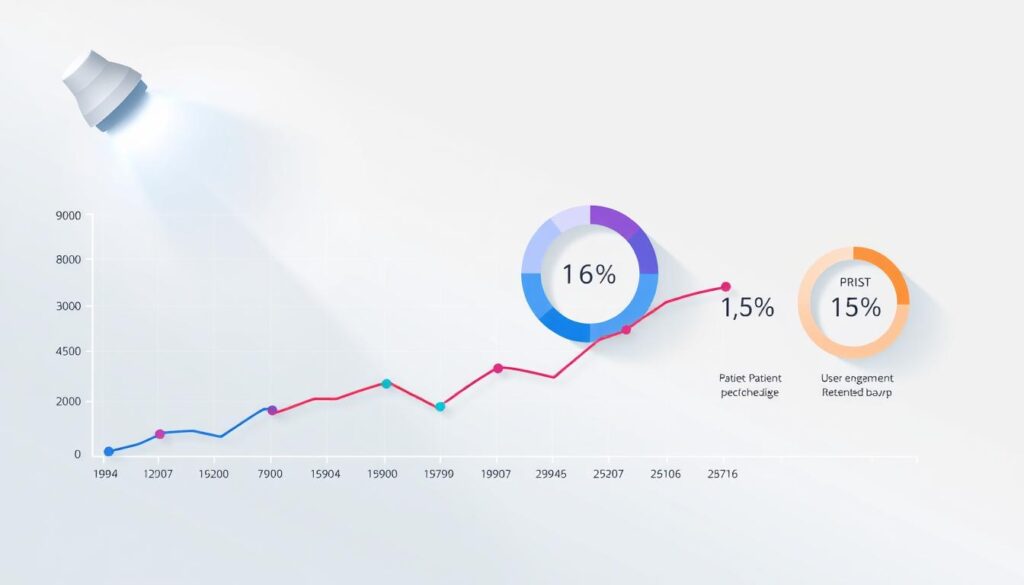The rise of telemedicine has transformed the healthcare industry, offering new business growth strategies and investment opportunities. With the help of digital health technologies, telemedicine has become a vital tool for providing healthcare services remotely, making it an attractive field for startups and investors seeking startup funding. As the healthcare industry continues to evolve, telemedicine is expected to play a significant role in shaping its future.
The growth of telemedicine has opened up new avenues for investment opportunities, enabling healthcare providers to expand their services and reach a wider audience. By leveraging digital health technologies, telemedicine has made it possible to provide high-quality healthcare services remotely, increasing accessibility and convenience for patients. This has created new business growth strategies for healthcare providers, allowing them to tap into the growing demand for virtual consultations and resources.
Key Takeaways
- Telemedicine has become a vital tool for providing healthcare services remotely
- Digital health technologies have enabled the growth of telemedicine, creating new business growth strategies
- Investment opportunities in telemedicine are on the rise, with startup funding available for innovative startups
- Telemedicine has increased accessibility and convenience for patients, improving healthcare outcomes
- The future of telemedicine looks promising, with continued growth and innovation expected in the coming years
The Evolution of Telemedicine: A Pre-Pandemic Perspective
Before the pandemic, telemedicine was already gaining traction, with a steadily increasing trajectory in the United States. However, its absolute integration remained low, and the logistics were complex. The use of AI and machine learning played a significant role in improving telemedicine services, enabling healthcare providers to offer more efficient and personalized care. This, in turn, had a positive impact on the stock market insights, with investors showing interest in the telemedicine industry.
As the industry evolved, personal finance tips emerged, highlighting the cost-effectiveness of telemedicine for patients. With the help of AI and machine learning, telemedicine platforms could analyze large amounts of data, providing valuable insights for healthcare providers and patients alike. This led to better health outcomes and improved patient satisfaction.
- Increased accessibility to healthcare services
- Reduced healthcare costs
- Improved health outcomes
These benefits, combined with the advancements in AI and machine learning, have contributed to the growth of the telemedicine industry. As the industry continues to evolve, it is likely that we will see even more innovative applications of AI and machine learning in telemedicine, leading to better stock market insights and personal finance tips for investors and patients.
COVID-19: The Catalyst for Digital Healthcare Transformation
The COVID-19 pandemic has accelerated the adoption of digital health technologies, including telemedicine, and has forced healthcare institutions to invest in cloud computing solutions and web development trends to support remote healthcare services. This shift has highlighted the importance of cybersecurity best practices in protecting sensitive patient data.
According to recent statistics, the pandemic has underscored the need for reliable and representative public health surveillance systems for infectious diseases. The consolidation of clinical microbiology laboratories has raised questions about its impact on detecting epidemiological changes related to COVID-19. In response, healthcare institutions have turned to cloud computing solutions to enhance their data management and analysis capabilities.
Some key benefits of adopting cloud computing solutions and web development trends in healthcare include:
- Improved data management and analysis capabilities
- Enhanced patient engagement and experience
- Increased efficiency and reduced costs
- Better cybersecurity best practices to protect sensitive patient data

As the healthcare industry continues to evolve, it is essential to prioritize cybersecurity best practices to ensure the confidentiality, integrity, and availability of patient data. By investing in cloud computing solutions and web development trends, healthcare institutions can improve their ability to respond to emerging health threats and provide high-quality patient care.
| Benefits | Cloud Computing Solutions | Web Development Trends |
|---|---|---|
| Improved Data Management | Enhanced data analysis and storage capabilities | Streamlined data collection and processing |
| Enhanced Patient Engagement | Personalized patient experiences through data-driven insights | Intuitive and user-friendly patient portals |
| Increased Efficiency | Automated workflows and reduced administrative burdens | Optimized clinical workflows and decision support systems |
Emerging Business Growth Strategies in Telemedicine
As the telemedicine industry continues to grow, new business strategies are emerging to meet the changing needs of patients and healthcare providers. The rise of telemedicine has opened up new opportunities for market expansion, revenue model innovations, and partnership ecosystems. SaaS marketing is playing a crucial role in this growth, enabling healthcare providers to reach a wider audience and provide more personalized care.
Telemedicine is not only limited to treating chronic illnesses but also extends to fitness and nutrition counseling, as well as mental health awareness programs. According to recent statistics, approximately 75% of healthcare expenditure in the US is dedicated to treating individuals with chronic illnesses, and telehealth strategies can help organizations manage patient engagement and reduce costs.
Some key benefits of telemedicine include:
- Remote monitoring in post-acute care settings
- Optimized reimbursement process through aligned services with payer requirements
- Reduced readmissions and hospitalizations through automated communication solutions
By leveraging these benefits, healthcare organizations can improve patient outcomes, reduce costs, and increase revenue. As the industry continues to evolve, it’s essential to stay up-to-date with the latest trends and innovations in telemedicine, including the integration of SaaS marketing, fitness and nutrition, and mental health awareness programs.
| Telemedicine Benefits | Description |
|---|---|
| Increased accessibility | Reduced need for travel and associated costs |
| Improved patient engagement | Remote monitoring and ongoing communication |
| Cost savings | Reduced readmissions and hospitalizations |
Investment Opportunities in the Digital Health Sector
The digital health sector has seen significant growth in recent years, with investment opportunities emerging in various areas, including weight loss programs and holistic medicine. As the healthcare industry continues to shift towards more personalized and preventive care, home workout routines and other digital health solutions are becoming increasingly popular.
According to recent data, the telehealth market is projected to reach $559.52 billion by 2027, representing a 25% annual growth rate. This growth is driven by the increasing adoption of digital health technologies, including AI-powered solutions and virtual care platforms. As a result, investors are taking notice, with US venture capital investments in the healthcare AI sector reaching $7.20 billion in 2023.
Some of the key areas of investment in the digital health sector include:
- Care delivery and navigation technology
- AI-powered solutions for disease diagnosis and treatment
- Virtual care platforms for remote patient monitoring and consultation
As the digital health sector continues to evolve, it’s likely that we’ll see more investment opportunities emerge in areas like weight loss programs, holistic medicine, and home workout routines. With the right investment and innovation, these solutions can help improve patient outcomes and reduce healthcare costs.

Overall, the digital health sector presents a significant opportunity for investors and innovators alike. With its growing market size, increasing adoption of digital health technologies, and potential for improved patient outcomes, it’s an area that’s worth exploring further.
| Investment Area | Market Size | Growth Rate |
|---|---|---|
| Telehealth | $559.52 billion | 25% |
| Healthcare AI | $7.20 billion | 20% |
Technological Infrastructure Driving Telemedicine Success
The success of telemedicine can be attributed to the technological infrastructure that supports it, including digital marketing strategies, SEO best practices, and social media marketing. According to recent data, the global Telemedicine Infrastructure Development Market size was valued at USD 51.44 billion in 2023 and is projected to expand at a compound annual growth rate (CAGR) of 18.6% during the forecast period.
Some key components of this infrastructure include:
- Hardware Components, such as video conferencing equipment and medical devices
- Software Solutions, such as electronic health records and telemedicine platforms
- Network Infrastructure, including 5G networks and reliable internet connectivity
These components work together to enable remote consultations, telemonitoring, and home healthcare, making it possible for patients to access healthcare services from anywhere. By leveraging digital marketing strategies, SEO best practices, and social media marketing, healthcare providers can reach a wider audience and promote their telemedicine services.
As the demand for telemedicine continues to grow, it is essential for healthcare providers to invest in the technological infrastructure that supports it. By doing so, they can improve patient outcomes, reduce costs, and enhance the overall quality of care.
| Component | Description |
|---|---|
| Hardware Components | Video conferencing equipment, medical devices |
| Software Solutions | Electronic health records, telemedicine platforms |
| Network Infrastructure | 5G networks, reliable internet connectivity |
Patient Adoption Metrics and User Experience Analysis
Understanding patient adoption metrics and user experience analysis is crucial in evaluating the effectiveness of telemedicine services. A demographics breakdown reveals that only 8% of adults in the U.S. regularly use healthcare apps, while 75.9% of medical professionals report using mobile health apps in their practice for only 0-5 hours per week.
To improve patient adoption, telemedicine services can leverage email marketing tips to engage with patients and provide personalized health insights. Additionally, online learning platforms can be used to educate patients about the benefits of telemedicine and how to use these services effectively.
A study found that 60% of surveyed consumers reported being more satisfied with their most recent telehealth appointment than with an in-person appointment. This highlights the potential of telemedicine to improve patient satisfaction and outcomes.

| Metric | Value |
|---|---|
| Regular healthcare app users | 8% |
| Medical professionals using mobile health apps | 75.9% |
| Patient satisfaction with telehealth appointments | 60% |
By analyzing these metrics and leveraging strategies like dropshipping business models, telemedicine services can improve patient adoption and provide high-quality care to a wider range of patients.
Regulatory Landscape and Compliance Requirements
The regulatory landscape and compliance requirements are crucial in ensuring the success of telemedicine services. As the industry continues to grow, it’s essential to consider career development tips for professionals in the field, including those who provide resume writing services and freelancing opportunities. By investing in these areas, telemedicine companies can mitigate operational risks and reduce the likelihood of workplace accidents.
Some key benefits of regulatory compliance include:
- Substantial long-term cost savings
- Mitigation of operational risks
- Improved employee satisfaction and productivity
- Enhanced brand reputation and customer trust
Companies that prioritize compliance can gain a competitive edge in the market, especially in highly regulated industries. By aligning regulatory compliance with strategic goals, businesses can achieve greater innovation and growth, leading to a stronger market position. As the telemedicine industry continues to evolve, it’s essential to stay ahead of the curve and prioritize compliance to ensure long-term success.
By following career development tips and leveraging resume writing services and freelancing opportunities, telemedicine professionals can stay up-to-date with the latest regulatory requirements and best practices, ultimately driving the industry forward.
| Regulatory Compliance Benefits | Description |
|---|---|
| Cost Savings | Reduced expenses associated with medical care, legal fees, and compensation claims |
| Risk Mitigation | Mitigation of operational risks, significantly reducing the likelihood of workplace accidents |
| Improved Productivity | Improved employee satisfaction and productivity, leading to higher engagement levels |
Healthcare Provider Integration Case Studies
As the healthcare industry continues to evolve, healthcare provider integration case studies have become crucial in understanding the effectiveness of telemedicine services. With the rise of remote job trends, digital marketing strategies, and SEO best practices, healthcare providers are now more equipped to reach a wider audience and provide quality care.
According to recent statistics, the U.S. health-tech market is projected to reach $89.4 billion by 2027, growing at a CAGR of 15.6% from 2023 to 2027. This growth is largely driven by the increasing adoption of digital health technologies, including telemedicine. In fact, 72% of U.S. healthcare providers reported using at least one international health-tech solution in 2023.
Some notable healthcare provider integration case studies include:
- Babylon Health, which secured partnerships with five major hospital networks and expanded its AI-driven diagnostic platform to serve 500,000 U.S. patients within 18 months of establishing its U.S. headquarters in Boston.
- Ada Health, which experienced a 200% growth in U.S. users post-launch of its AI diagnostic support tool, which achieved FDA clearance after validation studies with leading hospitals.

These success stories demonstrate the potential of remote job trends, digital marketing strategies, and SEO best practices in the healthcare industry. By leveraging these trends and strategies, healthcare providers can improve patient outcomes, increase efficiency, and reduce costs.
| Health-Tech Hub | Funding | Job Growth |
|---|---|---|
| Boston, Massachusetts | $3.2 billion | 28% |
| San Francisco, California | $4.5 billion | N/A |
Future Market Projections and Growth Potential
The telemedicine market is projected to experience significant growth, with a Compound Annual Growth Rate (CAGR) of over 38% from 2021 to 2028. This growth is driven by increasing adoption of business growth strategies and investment opportunities in the digital health sector. As the industry continues to evolve, new technologies and innovations will contribute to its expansion, creating opportunities for startup funding and further investment.
Some key statistics highlighting the growth potential of telemedicine include:
- The global digital health market is expected to reach approximately $504.4 billion by 2025.
- Virtual consultations accounted for approximately 25% of all outpatient visits during peak pandemic months.
- The percentage of patients willing to use telemedicine services rose from 11% in 2019 to 46% in 2020.
As the industry continues to grow, it is likely that we will see increased adoption of remote patient monitoring tools and other digital health technologies. This growth will be driven by business growth strategies and investment opportunities, as well as the increasing demand for convenient and accessible healthcare services. With the right startup funding and support, new companies and innovations will emerge, further driving the growth of the telemedicine market.
| Market Segment | Projected Growth Rate | Projected Market Size |
|---|---|---|
| Telepsychiatry | Higher than average | $9.5 billion by 2028 |
| Remote Patient Monitoring | 24.3% CAGR from 2021 to 2027 | N/A |
| Global Digital Health | 27.7% CAGR from 2020 to 2025 | $504.4 billion by 2025 |
Conclusion: The Sustainable Future of Digital Healthcare
As we look to the future, the sustainable growth of digital healthcare lies in the integration of cutting-edge technologies. AI and machine learning will play a pivotal role in enhancing diagnostic accuracy, streamlining clinical workflows, and personalizing treatment plans. Cloud computing solutions will provide the necessary scalability and accessibility to deliver healthcare services remotely, bridging the gap between patients and providers. Moreover, the continued advancements in web development trends will enable seamless, user-friendly telemedicine platforms, fostering greater patient engagement and satisfaction.
The digital health revolution has only just begun, and with the lessons learned from the COVID-19 pandemic, the healthcare industry is poised to embrace a more sustainable, technology-driven future. By leveraging the power of innovative solutions, the healthcare ecosystem can overcome infrastructure challenges, improve access to care, and ultimately deliver better outcomes for patients worldwide.
FAQ
What is the role of telemedicine in the post-pandemic healthcare landscape?
Telemedicine has become a vital tool for providing healthcare services remotely, with the help of digital health technologies. The growth of telemedicine has opened up new business growth strategies and investment opportunities, making it an attractive field for startups and investors.
How has the adoption of telemedicine evolved before the pandemic?
Prior to the pandemic, the adoption of telemedicine faced early challenges, including initial market response and healthcare provider resistance. However, the use of AI and machine learning has been instrumental in improving telemedicine services, contributing to its growth.
How has the COVID-19 pandemic accelerated the adoption of telemedicine?
The COVID-19 pandemic has been a catalyst for the digital healthcare transformation, accelerating the adoption of telemedicine and other digital health technologies. The importance of cloud computing solutions, web development trends, and cybersecurity best practices in supporting remote healthcare services has become more evident.
What are the emerging business growth strategies in the telemedicine industry?
Telemedicine is seeing the emergence of various business growth strategies, including market expansion opportunities, revenue model innovations, and partnership ecosystems. SaaS marketing, fitness and nutrition, and mental health awareness are also relevant to the telemedicine industry and can contribute to its growth.
What are the investment opportunities in the digital health sector?
The digital health sector, including telemedicine, presents attractive investment opportunities. Venture capital trends, public market performance, and risk assessment factors are important considerations. Weight loss programs, holistic medicine, and home workout routines are also relevant to the telemedicine industry and can contribute to its growth.
What technological infrastructure is driving the success of telemedicine?
Digital marketing strategies, SEO best practices, and social media marketing are key components of the technological infrastructure that is driving the success of telemedicine. These technologies have contributed to the growth of telemedicine and can be used to improve its services.
How are patient adoption metrics and user experience analysis shaping the telemedicine industry?
Understanding patient adoption metrics, such as demographics breakdown, satisfaction rates, and usage patterns, is crucial for the growth of telemedicine. Dropshipping business, email marketing tips, and online learning platforms are also relevant to the telemedicine industry and can contribute to its growth.
What are the regulatory requirements and compliance considerations for the telemedicine industry?
The telemedicine industry operates within a specific regulatory landscape and must adhere to compliance requirements. Career development tips, resume writing services, and freelancing opportunities are relevant to the telemedicine industry and can contribute to its growth.
How are healthcare providers integrating telemedicine into their practices?
Healthcare provider integration case studies, including success stories, implementation challenges, and ROI analysis, provide insights into the adoption of telemedicine. Remote job trends, digital marketing strategies, and SEO best practices are also relevant to the telemedicine industry and can contribute to its growth.
What is the future market potential and growth outlook for telemedicine?
The future market projections and growth potential of telemedicine are promising, with new business growth strategies and investment opportunities emerging. The industry is expected to continue evolving, with advancements in technologies and innovations driving its growth.
